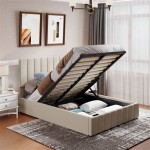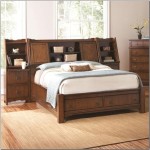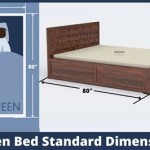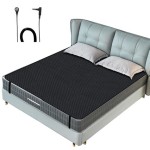Navigating Rug Sizes Under King Beds: A Comprehensive Guide
Selecting the correct rug size for placement under a king-size bed is a crucial aspect of interior design, impacting both the visual appeal and functionality of a bedroom. A rug that is too small can appear insignificant and disjointed, while one that is too large may overwhelm the space. This article provides a detailed guide to understanding appropriate rug sizes for king beds, covering various placement options, aesthetic considerations, and practical implications.
Understanding Standard King Bed Dimensions
Before considering rug sizes, it's essential to know the standard dimensions of a king-size bed. Typically, a king bed measures 76 inches (193 cm) in width and 80 inches (203 cm) in length. These dimensions serve as the foundation for determining the ideal rug size. Variations in these measurements can occur, particularly with California King beds (72 inches wide x 84 inches long) or custom-made frames. Always measure the bed frame itself to ensure accurate rug selection.
Knowing the bed's dimensions allows for calculating the amount of rug that will be visible around the bed, a key factor in achieving a balanced and aesthetically pleasing look. The desired amount of rug exposure will influence the final rug size selection.
Common Rug Placement Options and Sizing
Several popular rug placement strategies exist for king-size beds, each dictating a different optimal rug size. The most common methods involve varying degrees of rug coverage around the bed.
Option 1: The Full Coverage Method
This approach involves placing a large rug that extends significantly beyond the perimeter of the bed, typically covering a substantial portion of the room. For a king-size bed, a rug size of 9x12 feet (108x144 inches) or 10x14 feet (120x168 inches) is generally recommended. This option is best suited for larger bedrooms where the rug can define the entire sleeping area and create a sense of cohesiveness. With this approach, the rug provides a soft surface to step onto from all sides of the bed.
A 9x12 rug will leave approximately 16 inches of rug extending beyond the sides of the bed and 32 inches beyond the foot of the bed, assuming the rug is centered. A 10x14 rug will provide even more coverage, extending 22 inches on each side and 44 inches at the foot.
Option 2: The Three-Quarters Coverage Method
This is a frequently chosen approach, providing a balanced look without overwhelming the room. The rug is positioned beneath the bed, extending from the headboard to approximately two-thirds down the length of the bed and extending outwards on both sides. A rug size of 8x10 feet (96x120 inches) is a suitable choice for this placement. This allows for a comfortable landing space when getting out of bed and visually anchors the bed within the room.
With an 8x10 rug, approximately 10 inches of rug will extend on each side of the bed, and 16 inches will extend beyond the end of the bed, creating a defined border. This approach is particularly effective in smaller to medium-sized bedrooms.
Option 3: The Runner Method
This minimalist approach involves placing runners on either side of the bed. Runners are long, narrow rugs, typically measuring 2-3 feet in width and 6-8 feet in length. This option is ideal for smaller bedrooms or for those who prefer a more subtle rug presence. Runners provide a soft surface to step onto when getting out of bed, without covering a large portion of the floor. This is also a cost-effective option compared to larger area rugs.
When using runners, ensure they are long enough to extend beyond the bedside tables, providing a visually balanced look. Measure the length of the bedside table and add a few inches on either side to determine the minimum runner length.
Option 4: The Front Legs Only Method
This placement involves positioning the rug so that only the front legs of the bed and any accompanying furniture (like bedside tables) rest on the rug. This method aims to define the bed area without significantly covering the floor. A rug size of 6x9 feet or 5x8 feet can work, depending on the size of the bedside tables. The rug should extend far enough beyond the front legs of the bed to provide adequate visual balance.
With this method, the rug acts as a visual anchor, subtly defining the sleeping zone. It's a suitable choice for bedrooms where the flooring is a design element, and minimal rug coverage is desired.
Factors Influencing Rug Size Selection
Several factors beyond bed dimensions play a role in determining the optimal rug size. Consider these elements to make an informed decision.
Room Size and Layout
The overall size and shape of the bedroom are paramount. In a large bedroom, a smaller rug may appear lost and insignificant. Conversely, a large rug in a small bedroom can overwhelm the space and make it feel cramped. Analyze the room's dimensions and consider the placement of other furniture, such as dressers, chairs, and desks. The rug should complement the overall layout and create a sense of balance.
If the room is narrow, consider running the rug lengthwise to visually lengthen the space. In a square room, a square or round rug can add visual interest. Pay attention to doorways and walkways to ensure the rug does not obstruct movement or create a tripping hazard.
Furniture Placement
The placement of other furniture within the room will influence the rug size and placement. If bedside tables are present, consider whether they should be placed entirely on the rug, partially on the rug, or entirely off the rug. This decision impacts the rug's dimensions and overall visual appeal. Coordinating the rug with existing furniture ensures a cohesive and harmonious design. If you have a bench or ottoman at the foot of the bed, consider if the rug should extend to accommodate it.
Consider the height of the furniture legs and the thickness of the rug. A thick rug can make it difficult to open drawers or doors if the furniture is positioned too close to the edge of the rug.
Aesthetic Preferences and Style
Personal taste plays a significant role in rug selection. Some individuals prefer a minimalist aesthetic with minimal rug coverage, while others prefer a more opulent style with a large, plush rug. Consider the overall design style of the bedroom, whether it is modern, traditional, bohemian, or eclectic. The rug should complement the existing décor and enhance the overall ambiance of the room. Choose a rug color, pattern, and texture that align with personal preferences and the desired aesthetic.
Consider the rug's texture and pile height. A high-pile rug provides a luxurious and comfortable feel underfoot, while a low-pile rug is easier to clean and maintain. The rug's color and pattern can also significantly impact the room's visual appeal. A bold, vibrant rug can add a pop of color and personality to a neutral bedroom, while a neutral rug can create a calming and serene atmosphere.
Practical Considerations and Guidelines
Beyond aesthetics, several practical considerations should guide rug selection.
Material and Durability
Choose a rug material that is appropriate for the level of foot traffic in the bedroom. Wool rugs are durable, stain-resistant, and soft underfoot, making them an excellent choice for high-traffic areas. Synthetic materials like nylon and polypropylene are affordable, easy to clean, and resistant to fading. Natural fibers like cotton and jute are eco-friendly and provide a casual, relaxed look.
Consider the rug's construction and weave. A tightly woven rug is more durable and resistant to shedding than a loosely woven rug. If you have pets or allergies, consider a hypoallergenic rug made from natural or synthetic fibers.
Maintenance and Cleaning
Consider the ease of cleaning and maintenance when selecting a rug. Light-colored rugs are more prone to staining than dark-colored rugs. High-pile rugs can be more difficult to clean than low-pile rugs. Choose a rug that is easy to vacuum and spot-clean. Consider professional cleaning services for heavily soiled rugs. Always follow the manufacturer's cleaning instructions to avoid damaging the rug.
A rug pad is essential for protecting the rug and the floor underneath. Rug pads prevent the rug from slipping, reduce wear and tear, and provide extra cushioning. Choose a rug pad that is slightly smaller than the rug to prevent it from being visible around the edges.
Budget Considerations
Rugs can range in price from affordable to expensive, depending on the material, size, and design. Set a budget before beginning the rug search to avoid overspending. Consider the long-term value of the rug and choose a rug that is durable and will last for many years. Shopping online or at discount retailers can often provide access to a wider selection of rugs at more affordable prices. Consider waiting for sales or clearance events to purchase a rug at a discounted price.
Remember to factor in the cost of a rug pad and professional cleaning services when budgeting for a rug.

Everything To Know About Placing A Rug Under Your Bed

Rug Under Bed Sizes King Queen Double Child Images Bennetts Carpets

Rug Size For King Bed Rugs Sizes Guide How To Choose

What Size Rug Should I Use Under A Bed Mcqueens Interiors

Rug Size For King Bed The Best Layouts You Can Try Homilo

How To Choose Bedroom Rug Size

What Size Rug Goes Under A King Bed To Get The Best Match

Area Rug Sizes And Placement Guide Hey There Home

The Right Rug Size For A King Bed Morris Mansion

Bedroom Rug Over Carpet Honey We Re Home








